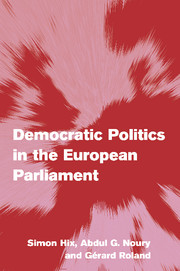Book contents
- Frontmatter
- List of Contents
- List of figures
- List of tables
- List of boxes
- Acknowledgements
- Introduction
- Chapter 1 Development of the European Parliament
- Chapter 2 Democracy, transaction costs and political parties
- Chapter 3 Ideological not territorial politics
- Chapter 4 Participation
- Chapter 5 Trends in party cohesion
- Chapter 6 Agenda-setting and cohesion
- Chapter 7 Who controls the MEPs?
- Chapter 8 Competition and coalition formation
- Chapter 9 Dimensions of politics
- Chapter 10 Investiture and censure of the Santer Commission
- Chapter 11 The Takeover Directive
- Conclusion
- Bibliography
- Index
Chapter 7 - Who controls the MEPs?
Published online by Cambridge University Press: 22 September 2009
- Frontmatter
- List of Contents
- List of figures
- List of tables
- List of boxes
- Acknowledgements
- Introduction
- Chapter 1 Development of the European Parliament
- Chapter 2 Democracy, transaction costs and political parties
- Chapter 3 Ideological not territorial politics
- Chapter 4 Participation
- Chapter 5 Trends in party cohesion
- Chapter 6 Agenda-setting and cohesion
- Chapter 7 Who controls the MEPs?
- Chapter 8 Competition and coalition formation
- Chapter 9 Dimensions of politics
- Chapter 10 Investiture and censure of the Santer Commission
- Chapter 11 The Takeover Directive
- Conclusion
- Bibliography
- Index
Summary
We have so far excluded two possible explanations of growing party cohesion in the European Parliament. First, we found in Chapter 5 that parties have not become more cohesive and more competitive as a result of growing internal ideological homogeneity. Second, we found in Chapter 6 that growing party cohesion cannot be explained only by strategic control of the legislative agenda inside the European Parliament. There is genuine enforcement of party discipline.
However, there are at least two other possible explanations as to why disciplined party politics has emerged in the European Parliament. One is that the European political groups are able to force their MEPs to vote together, irrespective of the MEPs’ personal preferences or the preferences of the MEPs’ national parties. Another is that the national political parties that make up the European parties strategically choose to vote together and impose discipline on their MEPs even when their preferences diverge. At face value, these explanations might seem similar, in that in both cases national delegations of MEPs appear to be voting against their expressed preferences under pressure from the European political groups. However, they are in fact different. The first explanation assumes that the national political parties are acting involuntarily, while the second assumes that national political parties are acting voluntarily upon some strategic objective, such as a long-term collective policy goal rather than the immediate outcome of a particular vote. The first explanation is top-down while the second one is bottom-up.
- Type
- Chapter
- Information
- Democratic Politics in the European Parliament , pp. 132 - 146Publisher: Cambridge University PressPrint publication year: 2007
- 1
- Cited by

